Tech
How to Download Netflix to MP4 to Watch Offline with iMovieTool Netflix Downloader
Netflix offers a massive collection of popular movies, original TV shows and award-winning documentaries for your entertainment. Netflix has removed Download function on Netflix app for Windows 11/10, and there is no official Netflix app for Mac, so the Netflix Mac users can only access and stream Netflix contents on a Mac through a web browser like Safari or Chrome by visiting netflix.com. However, if you want to download Netflix videos to computer for watching offline, it’s necessary to looking for third-part Netflix downloader for desktop.
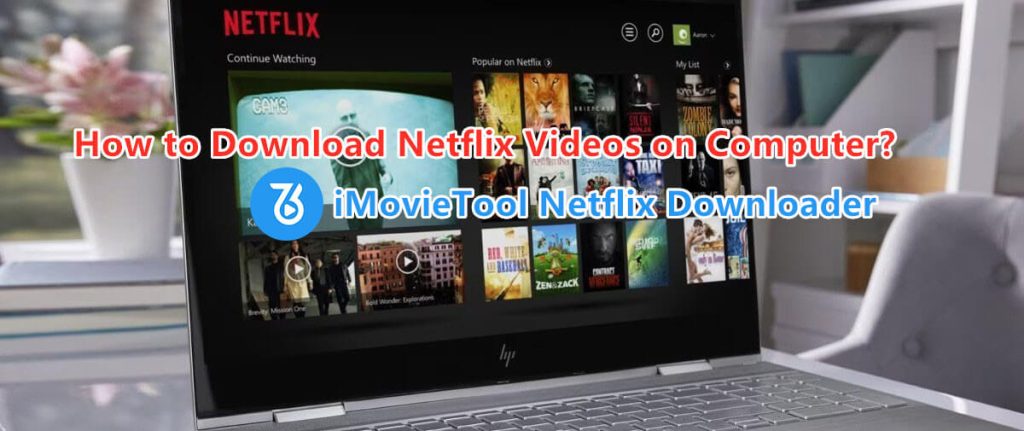
This is where tools like iMovieTool Netflix Downloader come into play, which can help you download Netflix to MP4 to watch offline without restrictions. In this full review on iMovieTool Netflix Downloader, we’ll take a deep dive into the software, including its highlights, features, and a step-by-step guide.

Common Pain Points for Netflix User
- Can iMovieTool Make Your Netflix Streaming Better?
- Distinguishing Features of iMovieTool You Shouldn’t Miss
- Pricing Plans of iMovieTool Netflix Downloader
- Steps to Download Netflix to MP4 with iMovieTool
- FAQs About iMovieTool Netflix Downloader
- Final Verdict
Common Pain Points for Netflix User
Before diving into iMovieTool’s features, it’s important to understand why users seek for ways to download Netflix to MP4. Many Netflix users experience frustration due to offline download restrictions. Netflix has not developed a Mac and Windows app with the same download function as its mobile apps.
For another, the Netflix downloads usually expire after 7 days or 48 hours. DRM protection prevents users from saving or transferring content outside the Netflix mobile app. Furthermore, device compatibility issues prevent streaming on older smart TVs, gaming consoles, or media players. To overcome these restrictions, downloading Netflix to MP4 is essential.
Can iMovieTool Make Your Netflix Streaming Better?
Yes. iMovieTool is a lightweight but useful tool for anyone who wants more freedom with their Netflix library. It aims to remove Netflix’s download limitations, allowing users to download Netflix videos on Mac or Windows PC without the Netflix app and store the Netflix videos as MP4 or MKV files. This diversity ensures compatibility with nearly any device or media player. Thus, users can keep Netflix videos forever, even if their subscription ends, and watch Netflix videos offline on any device without the Netflix app or an internet connection.
Distinguishing Features of iMovieTool You Shouldn’t Miss
iMovieTool Netflix Video Downloader features advanced technologies that help you download unlimited HD Netflix videos to MP4 for flexible playback. Below are the major features of iMovieTool Netflix Downloader:
Offer Versatile Formats
Netflix applied DRM protection to the content and set offline viewing restrictions (requiring an active subscription). iMovieTool Netflix Downloader effortlessly unlocks DRM protection and downloads Netflix videos in popular MP4 or MKV formats, ensuring your video collection remains accessible and playable without the fear of expiration dates or restrictions. This means you can transfer the downloaded Netflix videos to any other devices (such as smartphone, tablet, MP4 player, USB drive, game console, smart TV, etc.) for offline viewing.
Smart Searching Function
iMovieTool Netflix Downloader has been equipped with the official Netflix web browser inside the program, making the Netflix video searching to be much more effortless than other brands. It offers 3 tricks to easily search and locate your Netflix videos. First, it lets you type the name or keyword of Netflix movie/show for fuzzy search. Second, it allows you to copy and paste the Netflix video URL in the search field for precise search. Even better, you can directly browse and play the movie or TV show on iMovieTool, and download it right way!
FHD 1080p Resolution
iMovieTool Netflix Downloader gives you full control for your Netflix downloads. You can freely customize parameter settings like video format (MP4, MKV), video quality (low, middle, high), video codec (H264, H265) and more. It allows you to download Netflix videos in up to Full HD 1080p resolution on Mac and Windows. For Netflix movie downloads, it also preserves Dolby Digital 5.1 surround sound, ensuring the original visual and audio fidelity for a cinematic experience offline.
50X Ultra-fast Download Speed
One of the key highlights of iMovieTool is its fast 50X download speed. iMovieTool has applied the hardware acceleration technology inside the software, making it significantly faster than real-time recorder tools and online Netflix downloaders. Additionally, the software also provides a batch download mode, which can batch process entire episodes/seasons and multiple movies with one click. During my testing with a 20-episode TV series (approximately 40 minutes of each episode), iMovieTool Netflix Downloader completed the downloads in about 20 minutes.
Multilingual Audio and Subtitle Language
For global audiences, iMovieTool Netflix Downloader supports preserve audio tracks and subtitle in multiple languages for downloaded Netflix movies and TV shows, enhancing your offline viewing experience. Moreover, iMovieTool also provides three options for subtitles, including embedded subtitle, external subtitle, and hardcoded subtitle. Enjoy your favorite Netflix videos with subtitles in your preferred language at ease!
Pricing Plans of iMovieTool Netflix Downloader
iMovieTool software is available for both Windows and Mac computers, laptops. The free trial version lets you download the first 6 minutes of each video title. Currently, iMovieTool Netflix Downloader offers several pricing options for users, including:
- 1-Month Plan: $24.95 for PC/Mac
- 1-Year Plan: $59.95 for 1 PC/Mac
- Lifetime Plan: US$89.95 for 1 PC/Mac
All plans deliver one device license and include access to full features, unlimited Netflix downloads, free updates and technical supports.
For video lovers wanting multi-platform support, iMovieTool All-In-One Video Downloader offers unlimited downloads for Netflix, Amazon Prime, Hulu, HBO Max, Disney+, Apple TV+, Paramount+, YouTube, Facebook, Twitter, TikTok, and Instagram at prices of US$49.95 per month, US$99.95 per year, and US$149.95 for lifetime.
Steps to Download Netflix to MP4 with iMovieTool
Step 1. Download and Install iMovieTool Video Downloader
Visit the official website of iMovieTool from your computer’s web browser. Download and install the iMovieTool software for Mac or Windows.
If you purchase a registration, click the Key icon. In the pop-up window, select Netflix option in Service, and enter the registration code (that you received via email). Click “Register” button.

Step 2. Select Netflix Download Feature and Log Into Your Netflix Account
After installation, open the iMovieTool and choose “Netflix” platform.
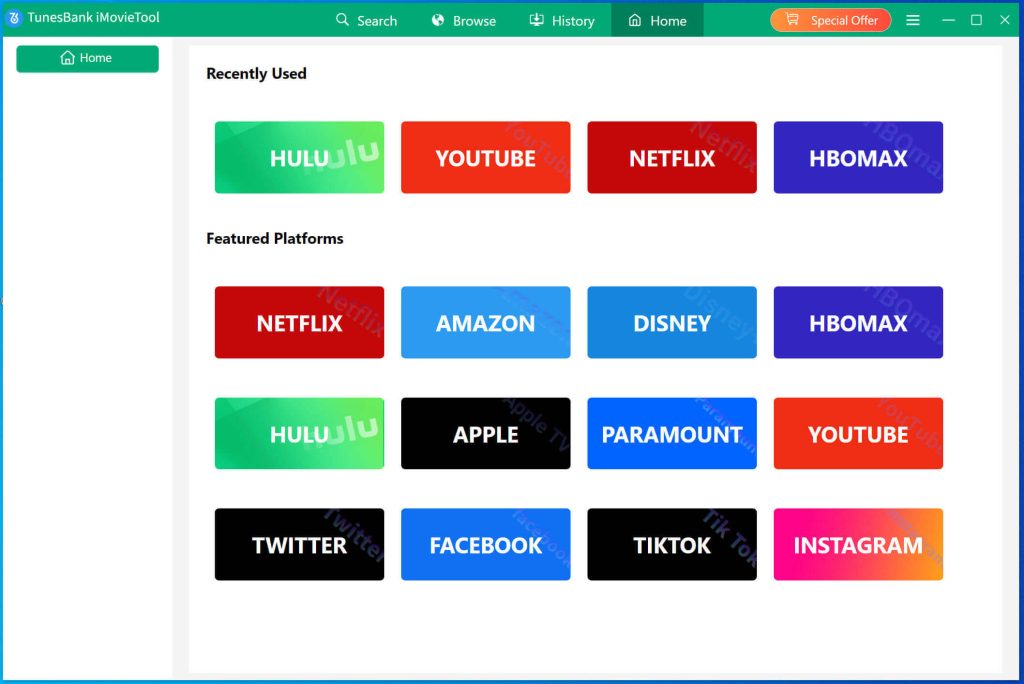
In the pop-up window, log into your Netflix account, either Netflix ad-supported or ad-free account. This gives you access the whole library of Netflix.
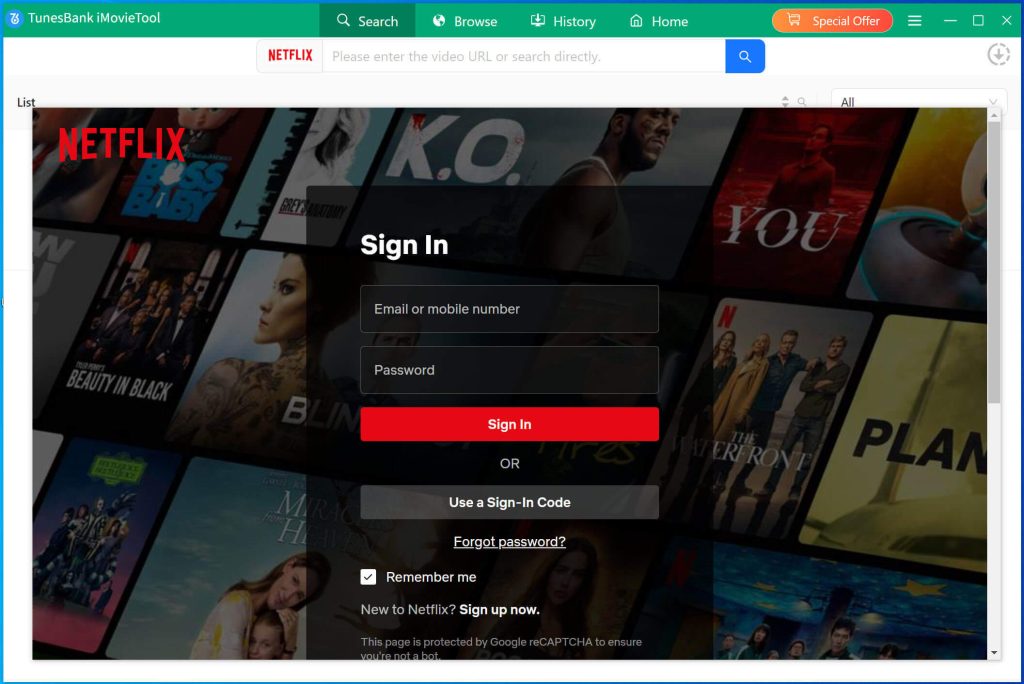
Step 3. Search for and Select Netflix Video
After successful login, you can search for movies or TV shows you want to download by name or URL. Or, you can browse through the various categories with the built-in web browser and add your preferred titles to download.
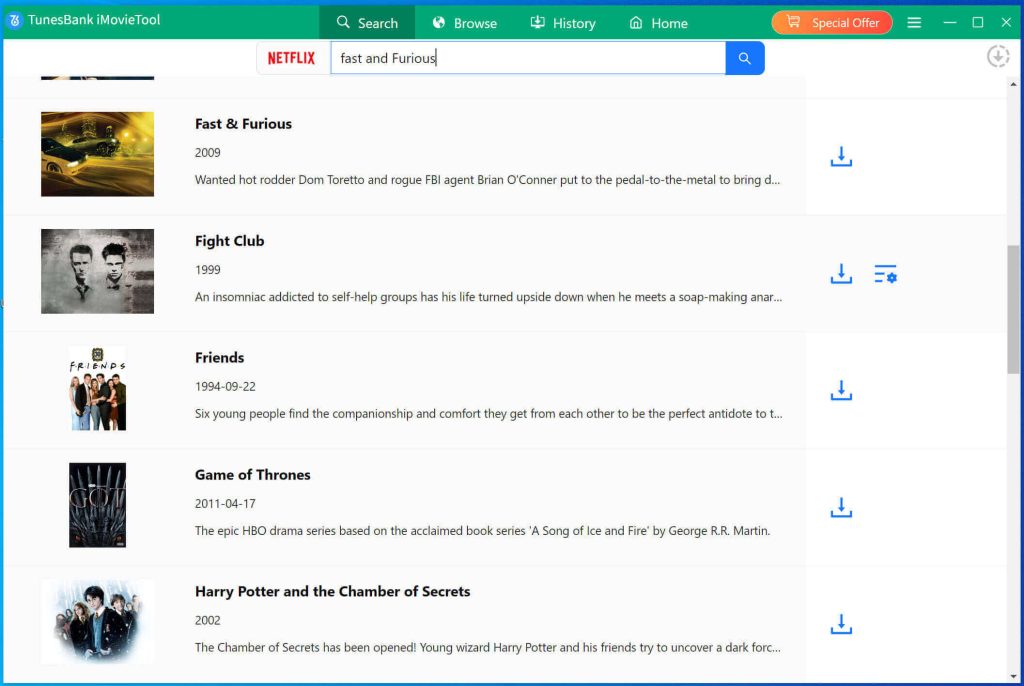
Step 4. Configure Output Settings
Before starting the download, click on the “Gear” icon at the upper righter, configure your preferences such as video format, video quality, video codec, audio language, subtitle, etc.
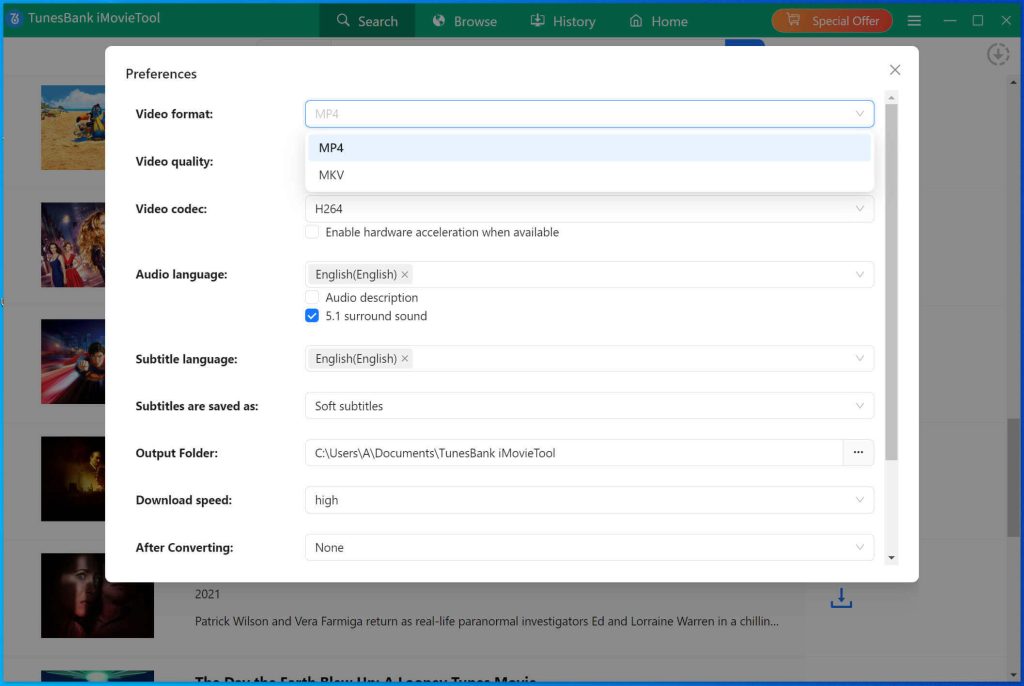
Step 5. Start Downloading Netflix Movies to MP4
After configuring your settings, click the “Download” button next to the title. You can see the video download progress in the right column and remove or pause the download at any time.

For TV episodes, you need to select your desired episodes or the entire episodes/seasons, then hit on “Download” button.
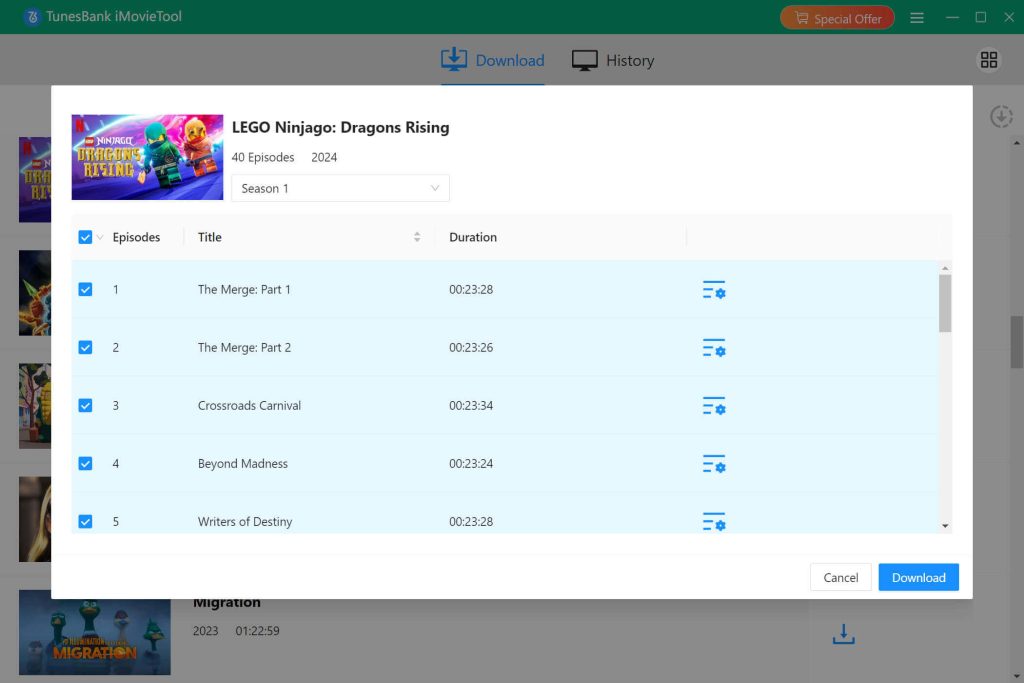
Step 6. Get Downloaded Netflix Videos
Once the download is complete, turn to the “History” section and access your downloaded Netflix videos offline!

FAQs About iMovieTool Netflix Downloader
Does iMovieTool Netflix Downloader Require a Netflix subscription?
Yes. Generally, Netflix is a subscription-based service, requiring a monthly or annual subscription, while iMovieTool also requires a login to access the video content from the country/region you subscribe to.
Can I Download Netflix to MP4 with Netflix Standard with Ads Account?
Yes. iMovieTool Netflix Downloader supports all subscription tiers of Netflix, whether you are using a Netflix ad-supported or ad-free account.
Will My Netflix Downloads through iMovieTool Expire?
No. Don’t worry, iMovieTool Netflix Downloader lets you download and save Netflix videos as plain MP4 or MKV files directly to your computer folder, permanently, no expiration. Even if you stop the subscription on Netflix or iMovieTool, you can still keep and watch your downloaded content through iMovieTool app.
Final Verdict
Now you’ve gone through all information about iMovieTool Netflix Downloader. Is it worth a try? My answer is YES! The software offers a reliable service that helps users get rid of Netflix restrictions and download Netflix videos to MP4 or MKV format in 1080o quality, giving them greater flexibility for offline video playback. Furthermore, with the encryption removed by iMovieTool, all the Netflix downloads can be permanently saved on your local drive without expiration, even after your subscription ends. Watch Netflix offline anytime, transfer Netflix videos to USB drive and take your Netflix collection anywhere!
Tech
How To Bridge Front-End Design And Backend Functionality With Smarter API Strategy
Introduction: Building More Than Just Screens
We’ve all seen apps that look sharp but crumble the moment users push beyond the basics. A flawless interface without strong connections underneath is like a bridge built for looks but not for weight. That’s why APIs sit at the heart of modern software. They don’t just move data; they set the rules for how design and logic cooperate. When APIs are clear, tested, and secure, the front-end feels smooth, and the backend stays reliable.
The reality is that designing those connections isn’t just “coding.” It’s product thinking. Developers have to consider user flows, performance, and future scale. It’s about more than endpoints; it’s about creating a system that’s flexible yet stable. That mindset also means knowing when to bring in a full-stack team that already has the tools, patterns, and experience to move fast without cutting corners.
Here’s where you should check Uruit’s website. By focusing on robust API strategy and integration, teams gain the edge to deliver features user’s trust. In this article, we’ll unpack how to think like a product engineer, why APIs are the real bridge between design and functionality, and when it makes sense to call in expert support for secure, scalable development.
How To Define An API Strategy That Supports Product Goals
You need an API plan tied to what the product must do. Start with user journeys and map data needs. Keep endpoints small and predictable. Use versioning from day one so changes don’t break clients. Document behavior clearly and keep examples short. Design for errors — clients will expect consistent messages and codes. Build simple contracts that both front-end and backend teams agree on. Run small integration tests that mimic real flows, not just happy paths. Automate tests and include them in CI. Keep latency in mind; slow APIs kill UX. Think about security early: auth, rate limits, and input checks. Monitor the API in production and set alerts for key failures. Iterate the API based on real use, not guesses. Keep backward compatibility where possible. Make the API easy to mock for front-end developers. Celebrate small wins when a new endpoint behaves as promised.
- Map user journeys to API endpoints.
- Use semantic versioning for breaking changes.
- Provide simple, copy-paste examples for developers.
- Automate integration tests in CI.
- Monitor response times and error rates.
What To Do When Front-End and Backend Teams Don’t Speak the Same Language
It happens. Designers think in pixels, engineers think in data. Your job is to make a shared language. Start by writing small API contracts in plain text. Run a short workshop to align on fields, types, and error handling. Give front-end teams mocked endpoints to work against while the backend is built. Use contract tests to ensure the real API matches the mock. Keep communication frequent and focused — short syncs beat long meetings. Share acceptance criteria for features in user-story form. Track integration issues in a single list so nothing gets lost. If you find repeated mismatches, freeze the contract and iterate carefully. Teach both teams basic testing so they can verify work quickly. Keep the feedback loop tight and friendly; blame only the problem, not people.
- Create plain-language API contracts.
- Provide mocked endpoints for front-end use.
- Contract tests between teams.
- Hold short, recurring integration syncs.
- Keep a single backlog for integration bugs.
Why You Should Think Like a Product Engineer, Not Just A Coder
Thinking like a product engineer changes priorities. You care about outcomes: conversion, help clicks, retention. That shifts API choices — you favor reliability and clear errors over fancy features. You design endpoints for real flows, not theoretical ones. You measure impact: did a change reduce load time or drop errors? You plan rollouts that let you test with a small cohort first. You treat security, observability, and recoverability as product features. You ask hard questions: what happens if this service fails? How will the UI show partial data? You choose trade-offs that help users, not just satisfy a design spec. That mindset also tells you when to hire outside help: when speed, scale, or compliance exceeds your team’s current reach. A partner can bring patterns, reusable components, and a proven process to get you shipping faster with less risk.
- Prioritize outcomes over features.
- Measure the user impact of API changes.
- Treat observability and recovery as product features.
- Plan gradual rollouts and feature flags.
- Know when to add external expertise.
How We Help and What to Do Next
We stand with teams that want fewer surprises and faster launches. We help define API strategy, write clear contracts, and build secure, testable endpoints that front-end teams can rely on. We also mentor teams to run their own contract tests and monitoring. If you want a quick start, map one critical user flow, and we’ll help you design the API contract for it. If you prefer to scale, we can join as an extended team and help ship several flows in parallel. We stick to plain language, measurable goals, and steady progress.
- Pick one key user flow to stabilize first.
- Create a minimal API contract and mock it.
- Add contract tests and CI guards.
- Monitor once live and iterate weekly.
- Consider partnering for larger-scale or compliance needs.
Ready To Move Forward?
We’re ready to work with you to make design and engineering speak the same language. Let’s focus on one flow, make it reliable, and then expand. You’ll get fewer regressions, faster sprints, and happier users. If you want to reduce risk and ship with confidence, reach out, and we’ll map the first steps together.
Tech
Which SEO Services Are Actually Worth Outsourcing? Let’s Talk Real-World Wins
Okay, raise your hand if you thought SEO just meant stuffing keywords into blog posts and calling it a day. (Don’t worry, we’ve all been there.) Running a business comes with enough hats already, and when it comes to digital stuff, there’s only so much you can do on your own before your brain starts melting. The world of SEO moves quick, gets technical fast, and—honestly—a lot of it’s best left to the pros. Not everything, but definitely more than people expect. So, let’s go through a few of those SEO services you might want to hand off if you’re looking to get found by the right folks, minus the headaches.
Technical SEO—More Than Just Fancy Talk
If you’ve ever seen a message saying your website’s “not secure” or it takes ages to load, yeah, that’s technical SEO waving a big red flag. This stuff lives under the hood: page speed, mobile-friendliness, fixing broken links, and getting those little schema markup things in place so search engines understand what the heck your pages are about.
You could spend hours (days) learning this on YouTube or DIY blogs, but hiring a specialist—someone who does this all day—saves you a load of stress and guesswork. Sites like Search Engine Journal dig into why outsourcing makes sense, and honestly, after one too many late-night plugin disasters, I’m convinced.
Content Writing and On-Page Optimization (Because Words Matter)
Let’s not dance around it: great content still rules. But search-friendly content is a different beast. It needs to hit the right length, work in keywords naturally, answer genuine questions, and actually keep visitors hooked. Outsourcing writing, especially to someone who actually cares about your brand’s tone, is worth it for most of us.
On-page SEO, which is tweaking all those little details like titles, descriptions, internal links, and image alt text, is a time-eater. It’s simple once you get the hang of it, but when you’re trying to grow, outsourcing makes the most sense.
Link Building—Trickier Than It Looks
Here’s where things get a bit spicy. Backlinks are essential, but earning good ones (not spammy or shady stuff) takes relationship-building, tons of outreach, and real patience. You can spend all month sending emails hoping someone will give your guide a shout-out, or you can just hire folks with connections and a process. Just watch out for anyone promising “hundreds of links for dirt cheap”—that’s usually a shortcut to trouble.
Local SEO—Getting Seen in Your Own Backyard
Ever tried showing up for “pizza near me” only to find yourself on page 7? Local SEO isn’t magic, but it takes a special touch: optimizing your Google Business Profile, gathering reviews, and making sure your info matches everywhere. It’s honestly a job in itself, and most small teams find it way easier to have a local SEO pro jump in a few hours a month.
Reporting and Analytics—Don’t Go Blind
Last, don’t skip out on real reporting. If nobody’s tracking what’s working—and what’s not—you’re just flying blind. Outsourced SEO pros come armed with tools and real insights, so you can see if your money’s going somewhere or just swirling down the drain.
Wrapping Up—Be Realistic, Outsource Smarter
You’re good at what you do, but SEO is more like ten jobs rolled into one. Outsource the parts that zap your time or make your brain itch, and keep what you enjoy. Focus on the wins (more leads, higher rankings, fewer headaches), and watch your business get the attention it deserves.
Tech
White-Label SEO: Building Scalable Digital Marketing Partnerships
Table of Contents
- What Is White-Label SEO?
- Why Digital Agencies Choose White-Label Solutions
- How White-Label SEO Works in Practice
- Benefits for Small and Mid-Sized Agencies
- Risk Management and Quality Assurance
- White-Label SEO and Client Retention
- What to Look for in a White-Label SEO Partner
- Future Trends in White-Label SEO
What Is White-Label SEO?
White-label SEO refers to a business arrangement where an agency partners with a third-party provider to deliver SEO services under the agency’s own brand. Unlike traditional outsourcing, where the client may be aware of third-party involvement, white-label models ensure the service provider remains invisible to the end client. The agency retains control over client communication and branding while benefiting from the expertise and tools of seasoned SEO professionals.
This structure allows agencies to offer complete SEO solutions without needing deep in-house expertise, staffing, or technology. For those looking to deliver robust results while maintaining their branding, leveraging an established provider such as SEO white label by Vazoola is a popular route. As demand for scalable and specialized SEO services grows, white-label partnerships have become a cornerstone for forward-thinking digital marketing agencies.
Why Digital Agencies Choose White-Label Solutions
Agencies of all sizes frequently encounter resource constraints, particularly as clients ask for increasingly sophisticated services. Building an advanced SEO department in-house can be cost-prohibitive, requiring hiring, training, and constant adaptation to search engine algorithm changes. White-label solutions are attractive because they enable agencies to offer first-rate SEO without prohibitive investments.
Additionally, as the digital landscape evolves, clients seek integrated digital marketing strategies instead of disconnected services. With white-label SEO, agencies can rapidly expand their offerings, supporting their growth strategies while capturing a larger market share. This flexibility allows consultancies and digital agencies to remain competitive as demands for comprehensive solutions intensify.

How White-Label SEO Works in Practice
A typical white-label SEO partnership starts with thorough onboarding and aligning goals and processes between the agency and the provider. The agency submits client data and campaign objectives, while the provider crafts a tailored SEO strategy and implementation plan. Once campaigns are underway, the agency oversees communication with its clients, while the provider handles the technical execution—keyword research, link building, technical audits, or content creation.
White-label SEO providers support streamlined communication through client dashboards, branded reports, and regular performance updates. Consistent reporting helps agencies build trust and credibility with their clients without revealing the third-party provider. Workflow automation and transparency are central to success, as illustrated in case studies where agencies have seamlessly scaled from a handful to dozens of clients due to repeatable, managed processes. For further insights, consider Moz’s SEO Guide, a comprehensive resource on industry-accepted best practices.
Benefits for Small and Mid-Sized Agencies
White-label SEO is often a game-changer for small and mid-sized agencies because it equalizes the playing field with larger competitors. These agencies can deliver enterprise-grade SEO services by tapping into top-tier talent and technology while maintaining personalized client relationships. This versatility helps attract and retain clients who might otherwise gravitate toward major digital marketing firms.
Another key advantage is the ability to focus internal teams on their strengths, whether that’s account management, creative work, or strategy. Rather than spreading resources thin, agencies can direct their energy where it adds the most value. By outsourcing technical SEO, they reduce overhead and avoid the risks of hiring, training, and turnover.
Risk Management and Quality Assurance
A significant challenge in white-label SEO is ensuring consistent communication, maintaining transparency, and delivering dependable results. Agencies should adopt robust QA frameworks to monitor campaign progress, verify deliverables, and address issues promptly. Scheduled performance reviews, auditing tools, and transparent project management processes are essential to quality assurance.
To mitigate risks, agencies should establish transparent reporting systems and agree on milestones and metrics upfront. Following the guidance of established leaders like Moz can help agencies set clear expectations and implement best practices in all aspects of SEO campaign delivery.
White-Label SEO and Client Retention
Strong white-label partnerships foster long-term client retention. Agencies can consistently deliver value through outcome-focused campaigns—whether improving rankings, increasing organic traffic, or driving conversions. The ability to tap into a partner’s expertise and resources means agencies are better equipped to meet evolving client expectations and deliver measurable results over time.
The seamless integration of white-label services also allows agencies to provide end-to-end digital marketing solutions, reducing the need for clients to seek alternative providers.
What to Look for in a White-Label SEO Partner
Choosing the right white-label SEO partner is crucial. Agencies should prioritize experience, reputation, transparent processes, and technical scalability. A strong partner openly shares methodologies, provides real-time support, and can accommodate a growing client base without sacrificing quality or compliance.
Be wary of partners who promise rapid results without clear strategies, offer generic services, or lack documented reporting and quality control processes. Key questions to ask include: What is your approach to link building? How do you handle reporting and communication? What QA measures are in place? Review insights from trusted white-label news sources to compare industry-leading providers and inform your vetting process.
Future Trends in White-Label SEO
Automation, AI integration, and advanced analytics define the future of white-label SEO. Emerging tech platforms help streamline keyword research, content optimization, and reporting, delivering greater efficiency for agencies and their clients. As client expectations rise, providers focus on more sophisticated dashboards, granular analytics, and proactive strategic support.
Similarly, the partnership model is evolving. Agencies and white-label providers are moving toward deeper collaborations, with joint innovation and tailored solutions playing an increasing role. Agencies prioritizing adaptability and choosing forward-thinking partners will be best positioned to thrive in the changing landscape.
-
Tech1 year ago
AI and Freight Management
-
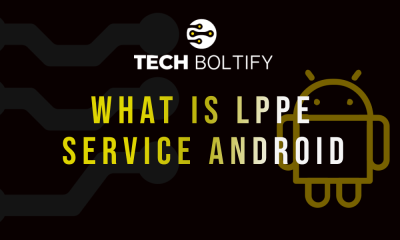
 Tech1 year ago
Tech1 year agoLPPe Service Android App and its Functions – How to Remove it
-

 Tech1 year ago
Tech1 year agoWhat is a Permission Controller – Control Manager Notifications
-
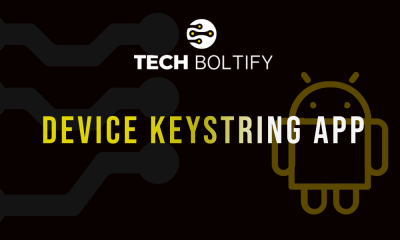
 Tech2 years ago
Tech2 years agoWhat is Device Keystring App On Android
-
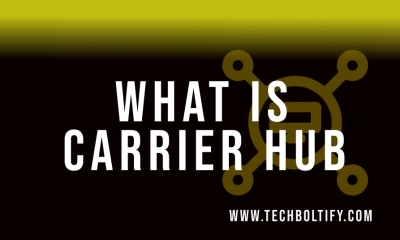
 Tech2 years ago
Tech2 years agoWhat is Carrier Hub – How to Resolve Processing Requests Issues
-

 Tech1 year ago
Tech1 year agoWhat is Summit IMS Service – How to Stop Syncing on Your Android Device
-
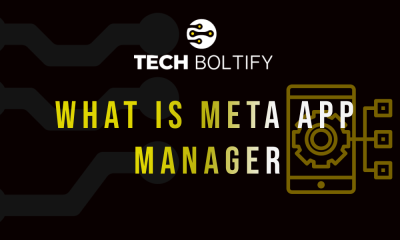
 Tech1 year ago
Tech1 year agoMeta App Manager – What is Meta App Installer
-

 Tech1 year ago
Tech1 year agoWhat is Cameralyzer Samsung – How to Fix or Uninstall Cameralyzer on Android

